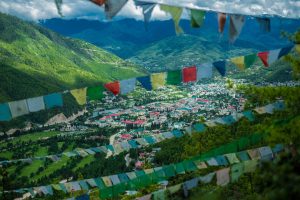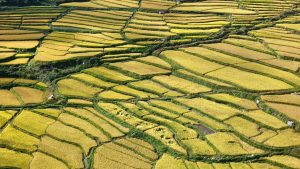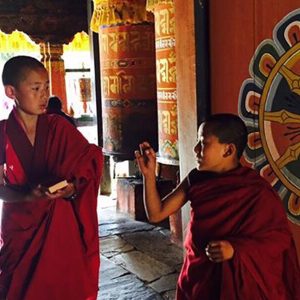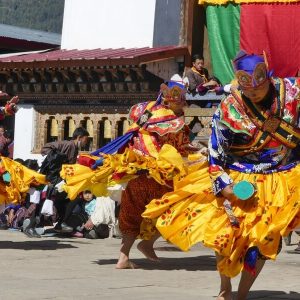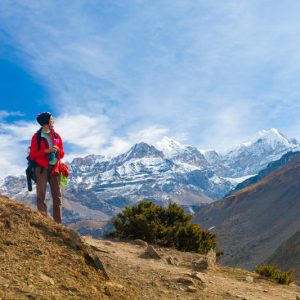When traveling to Bhutan, immersing yourself in the local culture goes far beyond visiting monasteries or hiking through the Himalayas—it also means connecting with people.
One of the best ways to do that is through language.
Do you wonder what language is spoken in Bhutan? Are you curious about where Dzongkha, the Bhutanese national language, comes from and how it is written? What are the key phrases every traveler should know before visiting Bhutan? And perhaps most importantly, do Bhutanese people speak English well enough for visitors to communicate easily?
Read on with Across Bhutan to explore the history of Dzongkha, its alphabet and pronunciation, and the essential words and expressions that will help you navigate your journey with confidence.
Similarities and Differences with Other Languages
Dzongkha belongs to the Tibeto-Burman branch of the Sino-Tibetan family.
It shares roots with Tibetan and Sikkimese, though it is not mutually intelligible with them.
In spoken form, it is partially understandable to Tibetans, but its tones and vocabulary make it unique.
Travelers should not expect similarities with Hindi or Nepali, even though those languages are spoken in Bhutan’s southern regions.
Instead, Dzongkha reflects Bhutan’s deep cultural and geographic ties to the Tibetan plateau, with its own distinctive identity shaped over centuries.
A Brief History of Dzongkha
Etimology
The word Dzongkha literally means “the language of the dzongs,” Bhutan’s fortress-monasteries that historically served as both administrative and spiritual centers. For centuries, Bhutan’s written tradition was dominated by Chöke, or Classical Tibetan, which was the language of religious texts, education, and governance. Local dialects flourished in the valleys, but there was no unified vernacular standard.
Adoption
In the early 20th century, some schools even used Hindi as a medium of instruction, reflecting Bhutan’s links with India. This changed in the 1960s, when the Third King, Jigme Dorji Wangchuck, declared Dzongkha the national language, establishing it as a cornerstone of Bhutanese identity. From that point on, Dzongkha began to replace Chöke in administration and education, and efforts were made to codify it as a modern language.
The year 1971 marked an important turning point, with the publication of the first “New Method Dzongkha Handbook,” which began to align the written form more closely with how people actually spoke. Dictionaries followed in the 1980s and 1990s, along with the development of official Romanization standards to help non-native speakers.
Romanization of Dzongkha
In 1991, the Dzongkha Development Commission introduced Roman Dzongkha, an official system to transcribe Dzongkha sounds into Latin letters. Unlike older systems that followed Tibetan spelling, this method reflects actual pronunciation.
It is based on the Thimphu–Punakha dialect and is now used in dictionaries, textbooks, and government resources. For travelers, it’s the most practical way to read and pronounce Dzongkha words without learning the script.
The Dzongkha Alphabet and Pronunciation
Dzongkha uses the Uchen script, derived from Tibetan.
Each character represents a consonant, often combined with vowels to form syllables.
For travelers, pronunciation can be challenging because tones and subtle distinctions matter, but Romanization makes it easier to learn the basics.
Here is the core alphabet with approximate English phonetics:
| Letter | Sound (IPA) | Approx. English Equivalent |
|---|---|---|
| ཀ ka | kɑ | “k” in kite |
| ཁ kha | kʰɑ | aspirated “k” |
| ག ga | gɑ | “g” in go |
| ང nga | ŋɑ | “ng” in sing |
| ཅ ca | tɕɑ | “ch” in cheese |
| ཆ cha | tɕʰɑ | aspirated “ch” |
| ཇ ja | dʑɑ | “j” in jam |
| ཉ nya | ɲɑ | “ny” in canyon |
| ཏ ta | tɑ | “t” in top |
| ཐ tha | tʰɑ | aspirated “t” |
| ད da | dɑ | “d” in dog |
| ན na | nɑ | “n” in net |
| པ pa | pɑ | “p” in pen |
| ཕ pha | pʰɑ | aspirated “p” |
| བ ba | bɑ | “b” in bat |
| མ ma | mɑ | “m” in man |
| ཙ tsa | tsɑ | “ts” in cats |
| ཚ tsha | tsʰɑ | aspirated “ts” |
| ཛ dza | dzɑ | “dz” in adze |
| ཝ wa | wɑ | “w” in water |
| ཞ zha | ʑɑ | “zh” like French jour |
| ཟ za | zɑ | “z” in zoo |
| འ ’a | ʔɑ | glottal stop, slight pause |
| ཡ ya | jɑ | “y” in yes |
| ར ra | rɑ | “r” (rolled or tapped) |
| ལ la | lɑ | “l” in light |
| ཤ sha | ɕɑ | “sh” in sheep |
| ས sa | sɑ | “s” in sun |
| ཧ ha | hɑ | “h” in hat |
| ཨ a | ɑ | “a” in father |
(This list covers the 30 main consonants. Vowels are added with diacritics, for example “ka, ki, ku.” Tones are high or low, but usually unmarked in romanization.)
English in Bhutan
Although Dzongkha is Bhutan’s national language, English is often the language you will use most as a traveler.
Since the 1960s, English has been the medium of instruction in Bhutan’s schools, meaning that younger generations speak it fluently.
In cities, hotels, restaurants, and with guides, you can expect smooth communication in English. Rural areas may be more mixed, but even there, basic English is common.
Bhutan does not appear in the official EF English Proficiency Index rankings, but anecdotal evidence and regional comparisons suggest a moderate to high proficiency level, especially in urban centers.
Many Bhutanese are as comfortable writing in English as they are in Dzongkha, which makes travel easier for international visitors.
That said, learning and using a few local phrases shows respect and often brings a warmer welcome.
Essential Dzongkha Phrases for Travelers
Even with English widely spoken, knowing some Dzongkha phrases makes a big difference. Here are some that cover different contexts:
Greetings and Politeness
- Kuzu zangpo – Hello / Greetings
- Gaday bay zhui? – How are you?
- Leg so – I’m fine
- Kadrinchey – Thank you
- Tashi Delek – Goodbye / Good luck
Everyday Basics
- In – Yes
- Me-in – No
Bargaining and Shopping
- Ani ga? – How much is this?
- Chig chey chom? – Is this your best price?
- Na thowa gi? – Can you make it cheaper?
- Nga gi chi go dey – I’ll take this one.
At a Restaurant
- Nga zhao ney – May I order?
- Zhe lesh gay? – What do you have?
- Nga gi… (dish name) yo – I would like…
- Nga gi chang yo – I’d like a beer.
- Nga gi ja yo – I’d like tea.
- Nga gi kaydrang yo – I’d like something spicy.
- Nga gi shamu yo – I’d like mushrooms.
- Nga saychö yong – Can I have the bill?
Asking for Directions
- Lam ga the? – Where is the road?
- Nga gi… ga di? – Where is… ?
- Norbu Ling ga di? – Where is Norbu Ling? (insert place name)
- Nga mi ga wor – I’m lost.
Safety and Emergencies
- Chhö zhu? – Is it safe?
- Nga roko! – Help me!
- Nga gi na di lha? – Is there a hospital nearby?
- Nga gi sowa chim gi the? – Where can I find medicine?
- Nga gi ga nyi? – Can you call someone for me?
Final Thoughts
While Dzongkha is at the heart of Bhutanese culture, you don’t need to worry about language barriers during your trip. English is widely spoken, especially by guides, drivers, and in hotels or restaurants, so you’ll always be able to get by. And since travel in Bhutan is carefully organized through licensed tour operators, visitors are well supported every step of the way.
Still, learning a few Dzongkha phrases adds color to your journey and shows genuine respect for local traditions. It’s a simple gesture that often leads to warmer interactions, smiles, and even unforgettable moments of connection.
At Across Bhutan, a trusted Bhutan travel agency, we design personalized Bhutan tours that go beyond the ordinary. Our expert team takes care of every detail while helping you experience authentic culture, meaningful encounters, and the natural beauty of the Land of the Thunder Dragon.

